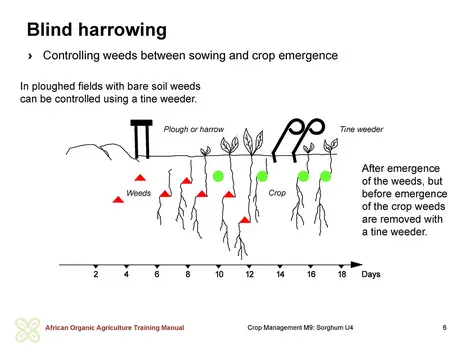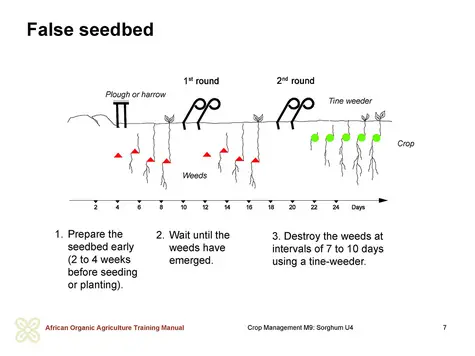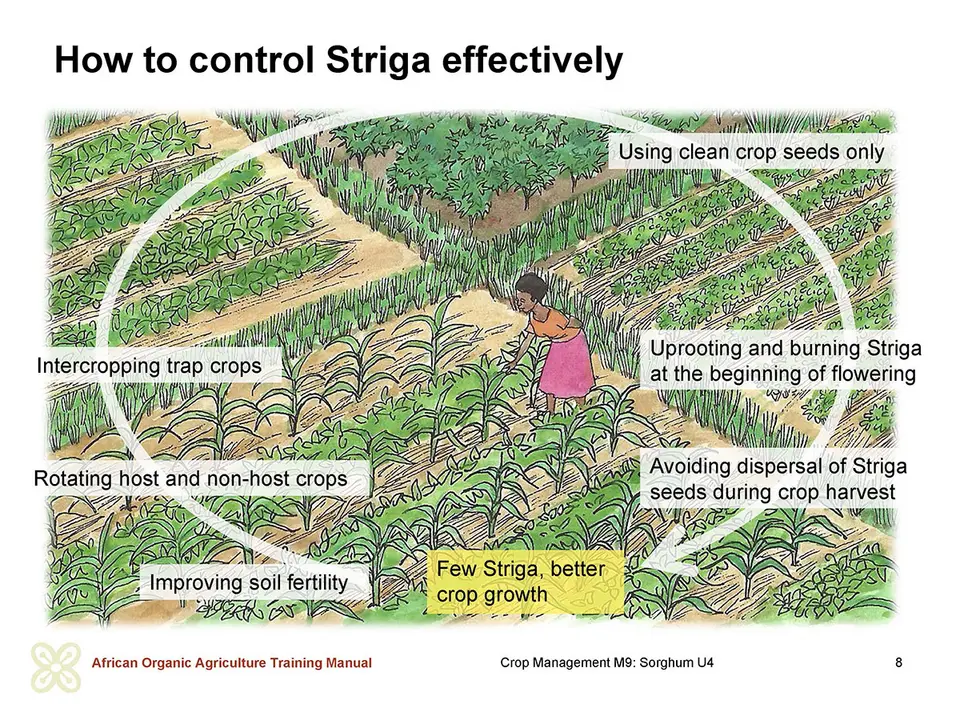Proper weed management
The aim of weed management is to minimise competition with sorghum during its growth as well as to avoid dissemination of weed seeds. As sorghum does not compete well with weeds during early growth until four to five weeks after planting, the crop requires special attention during this phase.
Various measures can be implemented in the management of weeds in sorghum production, these include:
Discussion: Weed management in sorghum production
Ask the farmers whether they experience any major weed problems. Identify the major weed species and note the local names. Identify the local weed control strategies that are being used in sorghum fields. Which measures have proven essential and effective?
a) Preventative and cultural measures
Prevention aims at restricting introduction and multiplication of weeds and ensuring good growing conditions for sorghum to limit competition for water, nutrients and light. Preventive measures include proper seedbed preparation (to ensure uniform stands), appropriate spacing (to ensure adequate plant populations), covering the soil surface with intercrops or cover crops and practising a proper crop rotation with densely growing legumes to regularly suppress weeds.
To some extent sorghum plants can compensate for poor stands by building several tillers per plant, but tiller production depends on good growing conditions. A dense and uniform crop discourages weed growth.
As a general rule the fields should always be kept covered with green or dry plants. This prevents uncontrolled development and propagation of weeds. Frequent problems with weeds generally indicate an unfavourable crop rotation. A sequence of crops with diverse growth habits in terms of duration and extent of soil covering prevents propagation of specific weeds. Regular growing of green manures that build a dense soil cover and suffocate the weeds can be essential to control competitive weeds. Well-managed green manures like Stylosanthes guianensis, Canavalia ensiformis (Jack bean) or Mucuna pruriens grow aggressively and establish a thick biomass, which kills most weed growths underneath. The green manure biomass, combined with straw beddings, will provide good mulching material to protect the soil and contributes to soil improvement when ploughed or dug into the soil at land preparation.
Growing an intercrop or a cover crop during growth of sorghum also contributes to the prevention of germination and development of weeds. Intercropping of Plumed cockscomb (Celosia argentea) has proved effective to control witchweed (Striga) in sorghum. To add an edible intercrop, beans (Phaseolus vulgaris) or another edible legume may be intercropped in addition to the catch crop. In arid climates though, growing a cover crop underneath the sorghum plants may result in competition for water and hinder growth of sorghum.
b) Mechanical control
Giving sorghum plants necessary attention at the early growth stages enhances their ability to compete well with weeds in the later stages of growth. In early growth of sorghum mechanical weeding can be difficult, because sorghum plants look similar to grass seedlings. Mechanical weeding is also not recommended immediately after the emergence of sorghum until the plants have formed three leaves, as at this stage the sorghum plants are sensitive to injuries and may be uprooted.
Weeding is commonly done with a hoe, but animal-drawn or tractor-drawn cultivators can be used, too. In case a drawn cultivator is used for inter-row cultivation, the weeds within the rows are removed by hand. Hand weeding can be done at the same time as thinning is carried out, or it is done at intervals if the thinnings are used to feed livestock.
The most common mechanical device for weed control in sorghum is a tine-weeder (a harrow with spring steel tines). Tine-weeding is very effective between sowing and plant emergence, as well as when the sorghum plants have three to four leaves and the weeds are not taller than 1 cm, when they are easy to pull out. Tine-weeding is most efficient when the soil is neither too dry nor too moist. To avoid uprooting of the sorghum seeds when harrowing, the crop must be sown sufficiently deep, the tine-weeder must be pulled slowly and be well-adjusted to scratch only the soil surface. Tine weeding may not be very efficient against grass weeds. Broadcast sorghum can only be mechanically weeded using a tine-weeder. Tine-weeding between sowing and plant emergence is called blind harrowing.
In case of low weed pressure, a single cultivation with the harrow may be enough, while in case of higher weed pressure, up to three consecutive passages at two weekly intervals may be necessary. Where couch grass is a problem, even more frequent weeding is necessary.
In cases of high weed pressure, weeding before sowing is most appropriate in order to reduce the weed stock in the topsoil. For this the seedbed is prepared early and the weed seeds are left to germinate. After approximately seven days, the soil is cultivated superficially again to uproot the weeds before planting the sorghum seeds. Irrigation of the soil after soil cultivation, where possible, increases the effectiveness of this method. In some cases, the sorghum seeds may be sown at the same time when the germinating weeds are being uprooted by hand or when superficial hoeing is carried out. This method is called false seedbed.
Management of Striga in sorghum production
The parasitic witchweed or Striga is a major constraint to sorghum production. The weed attaches itself onto the host’s roots, where it draws nutrients and water. The infested host eventually becomes stunted, yellowish or wilted and gives poor yields. Crops grown in soil with poor fertility suffer greater damage than vigorously growing crops. The weed is dispersed by tiny seeds through wind, water, tools, animals and humans, and crop seeds. The parasitic weed can lead to total grain losses of sorghum. Striga can be easily controlled by alternating sorghum with non-host or trap crops like groundnut, pigeon pea, Bambara bean, soybean, cowpea, cotton or sunflower. The trap crops induce germination of Striga, but do not serve as hosts. As a result the weed dies and the seed bank is reduced. Rotating sorghum with Striga trap crops (ideally with legumes to improve soil fertility) is an important preventive, as well as curative, control measure against Striga. Improved sorghum cultivars that are resistant or tolerant to Striga have been identified, but may not be available or affordable to farmers. A successful trap intercrop in sorghum is Plumed cockscomb (Celosia argentea), while in maize intercropping of silverleaf (Desmodium uncinatum) has proved to be efficient. Plumed cockscomb planted between the sorghum rows can reduce Striga emergence by more than half in one season and can increase the yield of a susceptible sorghum variety in the field by more than one third compared to a sorghum monocrop. Some agroforestry species such as Sesbania sesban and Leucauena diversifolia have been shown to result in reduced striga infestations in fields. Where these trees can grow, they may act as false hosts to the weed and at the same time contribute to better soil fertility and serve as windbreaks or give partial shade. The trees are best grown in hedge rows. Late sowing can also reduce Striga attack, but has a negative impact on yield. Therefore, a technique such as reduced tillage, which maintains a mulch soil cover and thus both allows early sowing and keeps soil temperature low, is a good option. Sustainable control of Striga also includes preventive measures that limit distribution of the weed, such as using uncontaminated seeds, cleaning soil and plant debris off machinery, shoes, clothing and tools before entering the fields, and rigorous removal of Striga plants before they flower.
Discussion: Mechanical control of weeds
Inquire among the farmers how common mecha-nical control of weeds is in the local context. If mechanical devices are used, discuss advantages and inconveniences of common practices and potential improvements.



 tap and then scroll down to the Add to Home Screen command.
tap and then scroll down to the Add to Home Screen command.